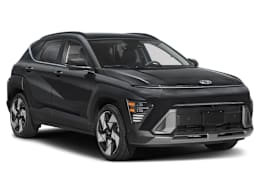The Kona has been redesigned and reimagined as a slightly upscale subcompact SUV. We found it an improvement in several ways over the previous model, which suffered from a stiff ride and a cramped cabin. The new Kona, which has grown larger with the redesign (and more expensive), sports a radically styled exterior and offers a roomier interior.
One of the areas where the little SUV shines is in its configurability, with two different internal combustion engines offered and either front- or all-wheel drive. There’s also an all-electric version. In addition, the Kona continues Hyundai’s strategy of offering a lot of features and technology for the money, with nice-to-have items such as a power driver’s seat, ventilated front seats, a surround-view camera system, and a power liftgate all available. We also appreciate that the Kona comes standard with just about every important active safety system, other than highway-speed automatic emergency braking, which is optional.
However, the Kona doesn’t feel unique or special out on the road. The driving experience is merely on a par with the rest of the subcompact SUV segment—rather than having moved the mark in terms of ride and handling capabilities, or cabin noise. As such, its road-test score is still well below the mark set by the Subaru Crosstrek.
We bought a Hyundai Kona SEL AWD—anonymously from an area dealer, as we do with every vehicle we test—for the purpose of this road test review.
Driving experience
The standard 147-horsepower, 2.0-liter four-cylinder engine and continuously variable transmission (CVT) are a mostly fine-performing pair. We appreciate that the Kona doesn’t suffer from any delays taking off from a stop, and delivers just enough power during around-town driving. The transmission is good enough that, as one tester said, “many drivers might not even realize it’s a CVT, thanks to the simulated upshifts that have been programmed in.” It’s only during moments when you press the gas pedal pretty hard that the CVT allows the engine revs to get high, which is also when the engine becomes very loud.
As with most little SUVs, there isn’t much power left in reserve when you need to move quickly. It took 9.8 seconds for the run from 0 to 60 mph, which is on the slower side for what is a pretty pokey segment. Unfortunately, the Kona also doesn’t shine in terms of fuel efficiency; we measured 26 mpg overall, which trails the Crosstrek, Kia Seltos, and Toyota Corolla Cross by 2 to 3 mpg.
We also tried a Kona with the up-level 1.6-liter turbocharged four-cylinder engine (which we rented from Hyundai for evaluation purposes) that produces 190 hp, matched with an eight-speed automatic transmission. While we appreciated its extra power at mid to high revs, we found it to hesitate at low speeds when getting back on the gas pedal, often followed by an abrupt burst of power shortly after. This makes it tricky to drive smoothly. It’s likely to get slightly worse fuel economy, according to the EPA figures.
It’s easy enough to take the Kona through corners, thanks to its small size. Although the steering has a slightly rubbery feel to it, which diminishes the driver’s connection to the road, it performed well in our handling tests at our track. We found the ride significantly more comfortable than the previous, overly-stiff Kona. The suspension remains firm, but it rarely allows truly harsh hits into the cabin. The interior is competitively quiet for the class, but it’s still louder than most vehicles. The engine, in particular, gets boisterous and buzzy when pushed to higher revs.
Cabin comfort
Hop inside the new Kona and you’ll discover a much roomier interior. Passengers benefit from a lot more elbow and shoulder room, there’s added legroom in the rear-seat area, along with a significantly larger cargo hold. Higher trims are available with a power-operated liftgate, which is rare for the subcompact SUV class. Cabin fit and finish is unimpressive, especially considering our test model’s $31,000-plus price. Although the curved display screens atop the dashboard look impressive—and we appreciate the high-quality steering-wheel stalks, buttons, and leather-wrapped steering wheel—the reality is that hard plastic abounds throughout the interior. We were also thoroughly annoyed by the abundance of unlined bins, which allow small items to just slide around through corners.
Our tested SEL trim comes with a power driver’s seat with two-way lumbar support adjustment. We found that the nicely shaped front seats do a good job holding you in place through corners, but the padding proved too firm for most drivers. Plus, the plastic door armrests get uncomfortable quickly, and numerous drivers complained that the top of the steering wheel cuts off part of the gauge cluster, which forced them to raise the wheel into a higher and less comfortable position so that they could see the entire instrument panel display. The rear seat is spacious for a subcompact SUV, with ample headroom, lots of foot space, and good under-leg support.
Controls and usability
The dashboard has a modern look, adapting the latest trend of presenting the driver’s instrument panel and infotainment screen on what appears to be one giant display (it’s actually two separate ones). The infotainment touchscreen is easy to use, and we appreciate the physical—rather than capacitive-touch—climate-control buttons. The twist-type, column-mounted electronic gear selector (part of the optional “Convenience” package fitted to our test vehicle, and standard on the upper N Line and Limited trims) takes some getting used to, but with practice it can be operated without looking at it. The Kona SE and SEL come standard with a traditional “PRND,” non-electronic console-mounted gear selector.
Safety
Standard active safety and driver assistance features include automatic emergency braking with pedestrian and cyclist detection, blind spot warning, rear cross traffic warning, reverse automatic emergency braking, lane centering assistance, lane departure warning, lane keeping assistance, and automatic high beams. Automatic emergency braking that operates at highway speeds and adaptive cruise control are optional.


























